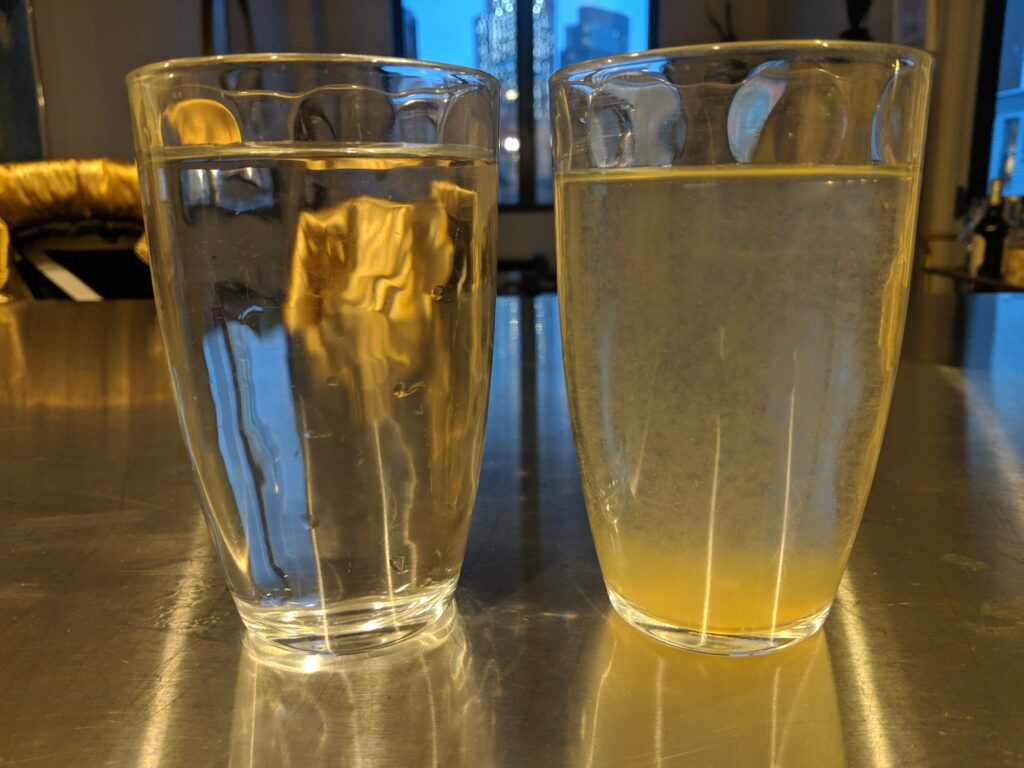You feel thirsty, so you grab a glass to get some water from your tap faucet. But as you turn it on, instead of getting clear crystal water, you notice a “milky” cloudy water in your cup.
So, what’s going on? Well, usually, there’s no cause for alarm.

The cloudiness is usually caused by trapped tiny air bubbles that escape after a while, taking the “cloud” with it.
Why your hot water is cloudy
To get the full picture, you must understand that water is stored in your water pipes under pressure.
This pressure allows gases and oxygen to get dissolved in the water. As the water gets heated, it loses its ability to hold or contain these dissolved gases.
In your water heater, these air bubbles from gases and oxygen look for a way to escape under intense pressure. That’s why you notice a cloudy appearance at the top as soon as you turn on your tap.
This is caused by the air bubbles trying to escape back into the air.
How your hot water turns cloudy.
In most cases, milky hot water results from dissolved oxygen and gas bubbles trying to escape.
However, there are two other reasons. In this section, we’ll go over all three of them.
Heating the water.
Lole we’ve discussed, water heaters reduce the capacity of water to contain dissolved gases and oxygen.
This creates room for the air bubbles to find an escape route. When you turn on your tap, this route is created, and the bubbles frantically find a way to get out.
Think of it like when you pop a bottle of champagne after shaking it for a while. At first, it’s a bit foamy but settles down and clears up later.
The faucet aerator.
Each tap comes with a tiny metal or plastic screen cap that fits at the end of the faucet.
It’s designed to reduce the splash and shape the water stream so it’s straight and evenly pressured.
Sometimes, this aerator gets clogged up, and the pressure increases, causing your hot water to be cloudy.
Other times, it can get dirty from mineral contamination if you have hard water. This will lead to your water being cloudy too.
Presence Of Sediment.
Due to the nature of water heaters, the pressure build-up can increase the sediments of minerals over time.
When this happens, your water turns out cloudy. If you notice this is the cause, it’s best to contact your local water maintenance and stick to bottled water instead.
Any health concerns related To drinking or using cloud water? Use this DIY test.
To help you decide, you’ll need to perform a simple test at home.
Take a transparent glass of water from your tap and leave it for a few minutes. If it clears up from top to bottom, it’s safe to drink or use for cooking.
However, if it stays cloudy for long hours, most likely at the bottom, there’s a high chance it has been contaminated with sediments, rust, or sand.
On a side note, if water from most faucets in your house is cloudy, then it’s likely caused by the municipal supply in your area. Most likely a switch from a good source.
Easy ways to fix cloudy, hot water.
Before you spend a ton of money hiring water services, you can troubleshoot to reduce or eliminate the occurrence of cloudy water.
These are simple fixes you can carry out easily.
1) Flush your water tank
Over time, sediments and calcium deposits build up at the bottom of your water heater. This results in clogged pipes and cloudy water.
To fix this, drain your water heater and allow water to flush through the heater, so all the sediments are removed.
2) Fix your aerator.
Sometimes your faucet’s aerator can get clogged up, causing you to experience cloudy water.
The first step will be to remove the aerator by turning your faucet clockwise. Then, wash up so that every sediment stuck on it is removed.
When you put back the aerator, you’ll get your clear crystal water again.
3) Check your water heater anode.
All water heaters come with an anode rod that attracts and removes sediments and rust from the heated water.
As with all things, the anode rod will wear off and lose its capabilities. This will result in a build-up of sediments. That’s why ensuring your anode rod is still functioning is important. If it’s not, then it should be replaced.

Jay
Jay is a health and wellness enthusiast with expertise in water quality and nutrition. As a knowledgeable advocate for holistic well-being, Jay successfully manages Type 2 Diabetes through informed lifestyle choices. Committed to sharing reliable and authoritative insights, Jay combines firsthand experience with a passion for enhancing health."
